Summary
Rev Bras Ginecol Obstet. 2020;42(8):501-507
Primary dysmenorrhea is defined asmenstrual pain in the absence of pelvic disease. It is characterized by overproduction of prostaglandins by the endometrium, causing uterine hypercontractility that results in uterine muscle ischemia, hypoxia, and, subsequently, pain. It is the most common gynecological illness in women in their reproductive years and one of the most frequent causes of pelvic pain; however, it is underdiagnosed, undertreated, and even undervalued by women themselves, who accept it as part of themenstrual cycle. It hasmajor implications for quality of life, such as limitation of daily activities and psychological stress, being one of themain causes of school and work absenteeism. Its diagnosis is essentially clinical, based on the clinical history and normal physical examination. It is important to exclude secondary causes of dysmenorrhea. The treatment may have different approaches (pharmacological, nonpharmacological and surgical), but the first line of treatment is the use of nonsteroidal anti-inflammatory drugs (NSAIDs), and, in cases of women who want contraception, the use of hormonal contraceptives. Alternative treatments, such as topical heat, lifestyle modification, transcutaneous electrical nerve stimulation, dietary supplements, acupuncture, and acupressure, may be an option in cases of conventional treatments’ contraindication. Surgical treatment is only indicated in rare cases of women with severe dysmenorrhea refractory to treatment.
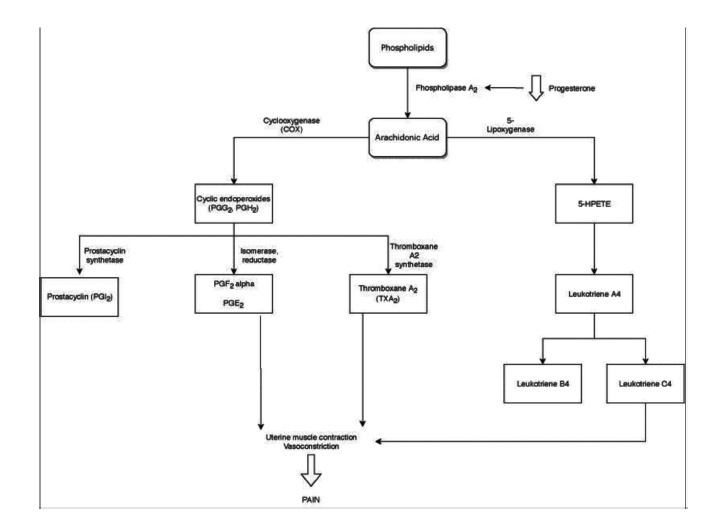
Summary
Rev Bras Ginecol Obstet. 2018;40(11):686-692
The aim of the present study was to assess the anthropometric measures, food intake and food cravings during the menstrual cycle of undergraduate students of the faculty of nutrition.
A cross-sectional study was performed with 27 students from a public university in the state of Mato Grosso do Sul, Brazil, who had their food intake evaluated through a 24-hour food recall, their nutritional status evaluated based on anthropometric measures, and food cravings evaluated using the Food Desire Questionnaire. Data were collected during an evaluation in the follicular phase (between the 5th and the 9th day of the menstrual cycle) and another in the luteal phase (LP) (between the 20th and the 25th day of the menstrual cycle). For food intake variables, the analysis of variance (ANOVA) test was used, followed by the Tukey test. The Mann-Whitney test was used for the analysis of food cravings, considering a significance level of 5% (p< 0.05).
The desire for foods rich in sugar, salt, and fat, such as chocolate, pastries, snacks and desserts were higher (p< 0.05) during the premenstrual period, although it did not reflect neither a higher energy intake nor an alteration in the distribution of macronutrients. A higher intake of carbohydrates, proteins, fibers, and calcium was observed during the LP; however, without statistical difference between the groups. There were no differences either in the intake of any food group or in the anthropometric measurements (p> 0.05).
Food cravings of nutrition students differed between the phases of the menstrual cycle; however, with no difference in food intake and in anthropometric measures.
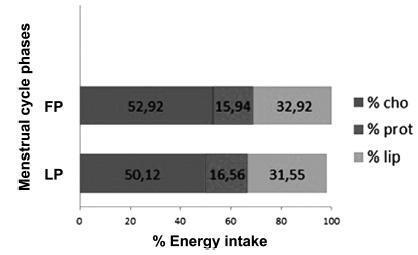
Summary
Rev Bras Ginecol Obstet. 2017;39(11):602-607
To investigate the level of anxiety and its relationship with interleukin (IL)- 10 (anti inflammatory cytokine that modulates mood swings) in a group of female soccer players.
Fifty-two eumenorrheic soccer players were evaluated (age 19.8 ± 4.7 years). The presence of premenstrual syndrome (PMS) and phases of the menstrual cycle were determined by a daily symptomreport (DSR) kept for 3 consecutivemonths. The concentration of cytokine IL-10 was determined from urine samples collected at four moments: at the follicular and luteal phases of the menstrual cycle, and before (pre) and after (post) the simulated game, and it was quantified by flow cytometry (Luminex xMAP - EMDMillipore, Billerica, MA, USA). The level of anxietywas determined through the BAI anxiety questionnaire answered by all athletes at the same time of the urine collection. The Student t-test, analysis of variance (ANOVA) and Pearson correlation with significance level at 5% were used for data analysis.
We showed that the prevalence of PMS among female soccer players is similar to that reported in the literature. In addition,we showed that the group withPMS has a higher level of anxiety compared with group without PMS (p = 0.002). Interleukin-10 analysis in players without PMS revealed that there was a significant decrease in the level of this cytokine before the game during the luteal phase when compared with the follicular phase (p < 0.05). The correlation analysis between IL-10 and anxiety showed a negative correlation post-game in the luteal phase in the group without PMS (p = 0.02; r = -0.50) and a positive correlation post-game in the luteal phase in PMS group (p = 0.04; r = 0.36).
Our results suggest that IL-10 may contribute to reduce anxiety in the group without PMS. This could be attributed to the fact that no IL-10 variation was observed in the group with PMS, which presented higher anxiety symptoms when compared with the group without PMS.
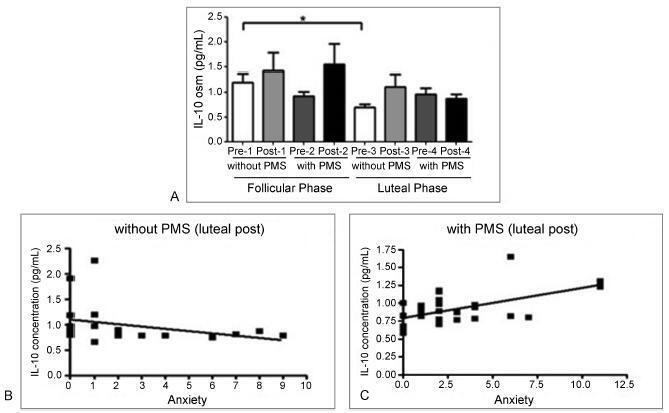
Summary
Rev Bras Ginecol Obstet. 2014;36(2):72-78
DOI 10.1590/S0100-72032014000200005
To compare salivary and serum cortisol levels, salivary alpha-amylase (sAA), and unstimulated whole saliva (UWS) flow rate in pregnant and non-pregnant women.
A longitudinal study was conducted at a health promotion center of a university hospital. Nine pregnant and 12 non-pregnant women participated in the study. Serum and UWS were collected and analyzed every trimester and twice a month during the menstrual cycle. The salivary and serum cortisol levels were determined by chemiluminescence assay and the sAA was processed in an automated biochemistry analyzer.
Significant differences between the pregnant and non-pregnant groups were found in median [interquartile range] levels of serum cortisol (23.8 µL/dL [19.4-29.4] versus 12.3 [9.6-16.8], p<0.001) and sAA (56.7 U/L [30.9-82.2] versus 31.8 [18.1-53.2], p<0.001). Differences in salivary and serum cortisol (µL/dL) and sAA levels in the follicular versus luteal phase were observed (p<0.001). Median UWS flow rates were similar in pregnant (0.26 [0.15-0.30] mL/min) and non-pregnant subjects (0.23 [0.20-0.32] mL/min). Significant correlations were found between salivary and serum cortisol (p=0.02) and between salivary cortisol and sAA (p=0.01).
Serum cortisol and sAA levels are increased during pregnancy. During the luteal phase of the ovarian cycle, salivary cortisol levels increase, whereas serum cortisol and sAA levels decline.
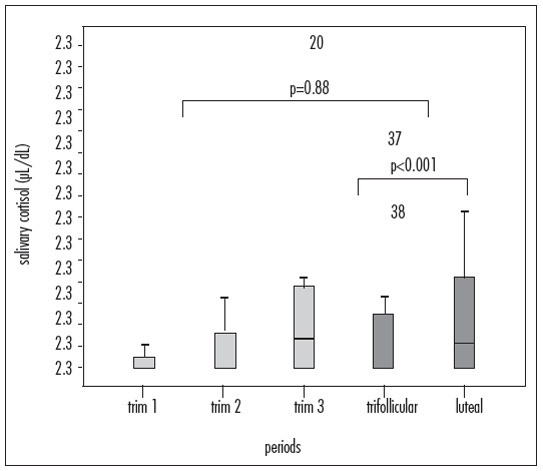
Summary
Rev Bras Ginecol Obstet. 2013;35(8):373-378
DOI 10.1590/S0100-72032013000800007
PURPOSE: To compare by transvaginal ultrasound the position of the intrauterine device (IUD) inside the uterine cavity, depending on the time of insertion, postpartum and post-abortion, and during the menstrual cycle. METHODS: Epidemiologic, observational and cross-sectional study carried out between February and July, 2013. A total of 290 women were included, 205 of them with insertion during the menstrual cycle and 85 during the postpartum and post-abortion periods. The independent variables were: age, parity, time of use, insertion time, number of returns to family planning, satisfaction with the method, wish to continue using the device, symptoms and complications. The dependent variable was the adequate position of the IUD inside the uterine cavity. The χ² test with Pearson's correction and the Fisher exact test were used for statistical analysis, with the level of significance set at 5%. RESULTS: The average age was 29.4 years and the average time of IUD use was 2.7 years; 39.3% of the women had symptoms associated with the method, the most frequent being menorrhagia (44.7%). The degree of satisfaction was 85% and 61.4% of the women returned two or more times for consultation about family planning. Age, parity and the position of the uterus in the pelvic cavity was not associated with a poor position of the IUD inside the uterine cavity (p>0.05). Insertion during the menstrual cycle was significantly more associated with a correct position of the IUD than postpartum and post-abortion insertion (p<0.028). CONCLUSION: Postpartum and post-abortion insertion showed worse results regarding the adequacy of IUD position, a fact that was not observed regarding age, parity or position of the uterus in the pelvic cavity.
Summary
Rev Bras Ginecol Obstet. 2013;35(5):210-214
DOI 10.1590/S0100-72032013000500004
PURPOSE: To determine the relationship between the level of physical activity and the incidence of premenstrual syndrome. METHODS: A cross-sectional design was conducted on 71 apparently healthy university students (24.4±4.8 yrs; 61.5±8.7 kg; 1.63±0.06 m). The level of physical activity was determined with a questionnaire and the presence of premenstrual syndrome was verified based on daily symptoms self-reported in a diary during two consecutive menstrual cycles. 17 premenstrual symptoms are considered in the diary, which should be scored on a 5-point scale (0-4) according to their occurrence, so that a score can be calculated in each cycle. The occurrence of premenstrual syndrome was considered if three or more symptoms were reported up to six days before menstruation (premenstrual period) and were absent up to six days after menstruation (postmenstrual period). RESULTS: The Spearman correlation coefficient showed a significant and negative relationship between the level of physical activity and premenstrual syndrome score (r=-0.506; 95%CI -0.335 to -0.678; p<0.001). When the participants were divided into a group with a positive diagnosis of premenstrual syndrome (n=31) and a healthy group (n=40), the Mann-Whitney test showed higher habitual physical activity in the healthy group than in the premenstrual syndrome group (7.96±1.17 and 6.63±1.20, respectively) (p<0.001). CONCLUSIONS: There is a negative relationship between the level of physical activity and the incidence of premenstrual syndrome, with women with a positive diagnosis of premenstrual syndrome having a lower level of physical activity than healthy women.
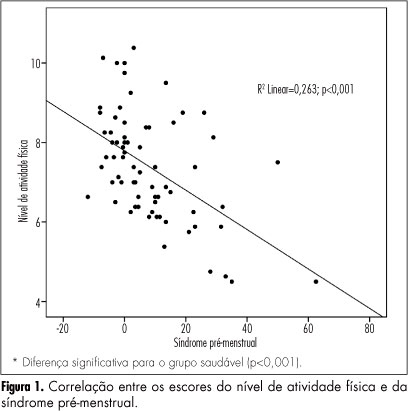
Summary
Rev Bras Ginecol Obstet. 2010;32(11):525-529
DOI 10.1590/S0100-72032010001100002
PURPOSE: to evaluate the characteristics of the menstrual cycle and to identify the occurrence of ovulation in nulliparous young women with sickle cell anemia (SCA). METHODS: we conducted a case-control study including 26 nulliparous women of reproductive age, divided into two groups: "cases", consisting of 13 women with SCA, and "Control" Group, consisting of 13 healthy women with the same interval since menarche. The characteristics of the menstrual cycle were reported by the participants, who were also submitted to measurements of serum progesterone, basal body temperature curves and transabdominal ultrasound in three consecutive cycles (total: 78 cycles) in order to identify the occurrence of ovulation. The results were compared between groups using the nonparametric Mann-Whitney or Kruskal Wallis tests, and the differences were considered significant when p-value < 0.05. RESULTS: no significant difference was found in mean chronological age between the two groups (p = 0.2) in the pattern of the menstrual cycle when duration of flow (p = 0.4) and interval between cycles (p = 0.3) were compared. There was no difference between groups in age at menarche (p = 0.05). Mean hemoglobin value was 8.4 g/dL (± 0.9) in the group of women with SCA and 12.6 g/dL (± 0.8) in the control group (p < 0.01). The frequency of ovulatory cycles was similar for cases (76.9%) and controls (92.3%) (p = 0.5), with a predominance of individuals with three ovulatory cycles in the control group (84.6%) compared to 23.1% in the case group (p = 0.04). CONCLUSION: the findings justify the need for effective guidance for patients with SCA regarding sexual activity, the possibility of pregnancy and the alternatives for contraception.
Summary
Rev Bras Ginecol Obstet. 2008;30(6):306-311
DOI 10.1590/S0100-72032008000600007
PURPOSE: to investigate the relationship between pain perception (experimental pain threshold and tolerance, in response to ischemia and pressure) in young and healthy young women and female sexual hormone seric levels (estradiol and progesterone). METHODS: 18 volunteers have participated of this study, during three consecutive menstrual cycles. A pressure algometer and a manual dynamometer have been used to measure painful responses to pressure and ischemia algesic stimuli. Blood has been collected for assessment of both hormonal and painful variables, during three menstrual cycles, whose characterization was based on daily oral temperature record, a diary of the menstrual cycles with the onset and end of each cycle, and on estradiol and progesterone plasmatic levels. The average for the algesic variables measured has been compared by analysis of variance (ANOVA) and the Tukey-Kramer's post-test, among the menstrual cycle phases (follicular, periovulatory, early luteal, late luteal and menstrual). The Pearson's test has been used for correlation analysis between algesic and hormonal variables. Statistical significance has been defined as p<0.05. RESULTS: no significant change in pain parameters among the menstrual cycle phases has been observed. Nevertheless, there have been significant negative correlations between progesterone and ischemic threshold (r=-0.23; p<0.01), and pressure tolerance (r=-0.23; p<0.01) at the early luteal phase. CONCLUSIONS: these results indicate that the increase in progesterone levels correlates with a decrease of ischemic threshold and pressure tolerance, suggesting that progesterone plays a role in the pain modulation during the early luteal phase.
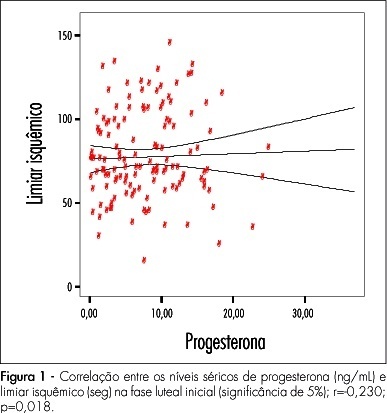
Search
Search in:
breast (42) breast cancer (42) breast neoplasms (95) Cesarean section (72) endometriosis (66) infertility (56) Maternal mortality (43) menopause (82) obesity (58) postpartum period (40) pregnancy (225) Pregnancy complications (99) Prenatal care (68) prenatal diagnosis (50) Prevalence (41) Quality of life (51) risk factors (94) ultrasonography (79) urinary incontinence (40) women's health (48)